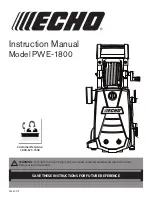
32
Stop
1.
Set the "ON/OFF" switch (3) to” OFF” position;
2.
Unplug the power cord (10);
3.
Close the water supply tap;
4.
Press the gun trigger (15) to relieve any water
pressure;
5.
Set the trigger safety lock (16) to the left to lock the
trigger;
6.
Wind up the high-pressure hose (9);
7.
Wind the water supply hose;
8.
Wind up the power cord (10) and place it in the
holder;
Never close the water supply tap off before
turning off the washer.
Nozzle adjustment - Spray pattern and water pressure
The spray pattern and the water pressure are set at the
nozzle (17 and 18).
A narrow-concentrated jet produces a stronger impact,
which results in deeper cleaning effect in a more
concentrated area. This type of jet should be used
carefully, as it can damage some surfaces.
A wider jet distributes the water impact over a larger
area, cleaning a larger area and reducing the risk of
damage to the surfaces to be cleaned.
The water outlet angle can be adjusted, between 0 and
60°. The use of a spray angle equal to 45°, allows an
efficient removal of debris, due to the combination:
impact force and jet cleaning area;
Another factor that determines the water impact force
is the distance between the nozzle and the surface to be
cleaned. The impact force increases as the nozzle
approaches the surface.
To make the adjustment, turn the adjustable nozzle (17
and 18) according to the required pressure and spray
pattern. To the left, the pressure drops; to the right, it
increases.
1.
To adjust the water outlet pattern, turn the nozzle
(18) clockwise to get a thinner/narrow jet.
Counterclockwise, you get a wider jet;
2.
To adjust the water outlet pressure, turn the nozzle
(17) clockwise to get a low-pressure jet.
Counterclockwise, you get a high-pressure jet;
Avoid cleaning windows with a narrow jet once it might
break the glass. Set the nozzle to a 45° spray angle.
Detergent application
Using detergent reduces cleaning time and increase the
efficiency on stains removal.
Use only detergents suitable for pressure washers. Do
not use other type of detergent or chemical that might
damage the pump or seals and affect the appliance’s
safety and performance.
Using thicker detergents, such as dishwashing
soap or car shampoo might clog the nozzle.
Most car shampoos are a combination of detergent and
wax. These ones tend to be viscous. Viscosity increases
in lower temperatures.
When using detergents combined with wax or
dishwashing soap, they shall be diluted in warm water
before using and according to the recommended
instructions on the detergent.
To operate the washer with detergent, you must follow
these instructions:
1.
Remove the detergent tank’s cap (23), add detergent
and refit the cap;
2.
To operate the appliance with detergent, you must
ensure that it operates at minimum pressure. Turn
the adjustable nozzle (17) clockwise until the limit is
reached;
3.
Use the detergent dosing button (2) to adjust the
detergent outlet. Turn the button counterclockwise
to increase the amount of detergent;
4.
Press the gun trigger to start cleaning;
Once you have finished cleaning, press the gun trigger
handle until clean water starts coming out. This
guarantees complete removal of detergent remains.
















































